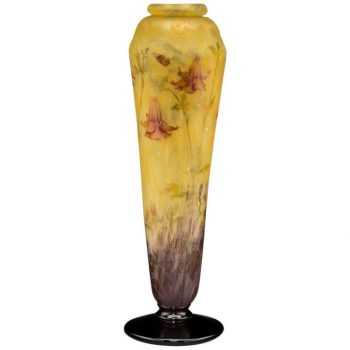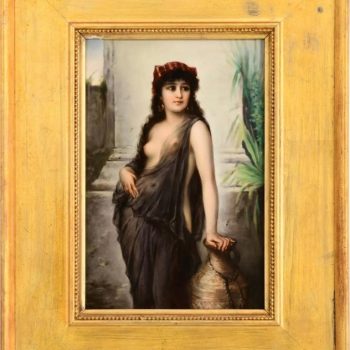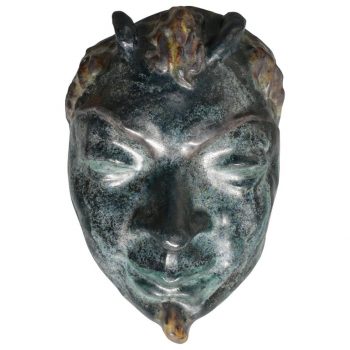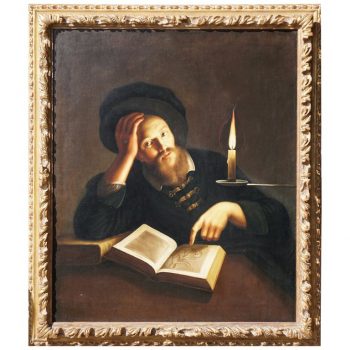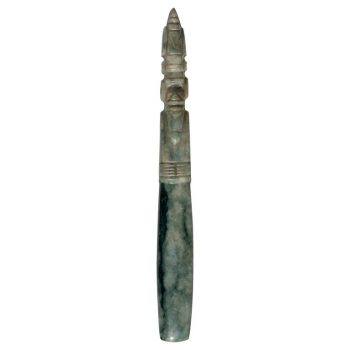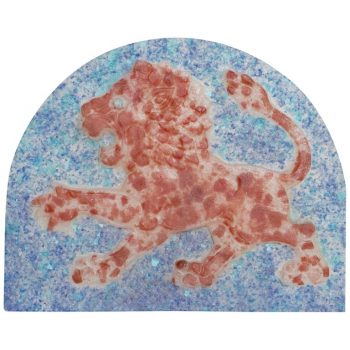Description
Loetz Art Nouveau circa 1900 art glass vases with floral and decorative scroll Silver Overlay. (Pair)
Larger: Corset form in iridescent gold glass decorated with scrolling silver overlay and a blank cartouche.
Height: 5.25 X 2.75 Diameter
Condition: Mint.
Smaller: Bulbous smoke stack form in iridescent green-gold decorated with scrolling silver overlay flowers.
Marked: Alvin pat 67
Height: 4.25 X 2,65 Diameter
Condition: Mint
AVANTIQUES is dedicated to providing an exclusive curated collection of Fine Arts, Paintings, Bronzes, Asian treasures, Art Glass and Antiques. Our inventory represents time-tested investment quality items with everlasting decorative beauty. We look forward to your business and appreciate any reasonable offers. All of our curated items are vetted and guaranteed authentic and as described. Avantiques only deals in original antiques and never reproductions. We stand behind our treasures with a full money back return if the items are not as described.
In 1836, Johann Eisner established a glassworks in the Southern Bohemian town of Klostermühle, today part of the Czech Republic and called Klášterský Mlýn. His heirs sold the glassworks to Martin Schmid in 1849, and two years later Schmid sold it to Frank Gerstner, attorney-at-law, and his wife Susanne. Susanne was the widow (‘Witwe’ in German) of Johann Loetz, a glassmaker about whom we know very little.
Gerstner transferred sole ownership to Susanne shortly before his death in 1855, and she successfully led and expanded the company during the subsequent 20 years, manufacturing mainly crystal, overlay and painted glass.
In 1879, Susanne transferred the company – now called ‘Johann Loetz Witwe’ – to Maximilian von Spaun, the son of her daughter Karoline. One year later, von Spaun hired Eduard Prochaska and the two of them modernized the factory and introduced new, patented techniques and processes.
The first fruits of this collaboration were exciting innovations in Historicism glass, including Intarsia and Octopus glass and the very popular marbled (‘marmorisierte’) glass which imitated semi-precious stones like red chalcedony, onyx and malachite. Success at exhibitions in Brussels, Munich and Vienna were crowned by awards at the Paris World’s Exposition in 1889.
In 1897, von Spaun first saw Tiffany Favrile glass exhibited in Bohemia and Vienna, and this convinced him that the art nouveau style was also the way to go for Loetz Witwe. The next eight years were to be the most artistically significant and profitable period in the entire history of the company.
The Art Nouveau Period –The glassworks created large numbers of its own new designs of iridescent, trailing art nouveau glass, sometimes in collaboration with well-known artists and designers like Marie Kirschner and Franz Hofstötter (aka Franz Hofstätter). The zenith of Loetz art nouveau glass was epitomized by the so-called Phänomen series of designs, much of it designed by Hofstötter, which won a Grand Prix (alongside Tiffany, Gallé, Daum and Lobmeyr) at the Paris World’s Exposition in 1900.
The company’s success during this period had two prime drivers – the technical expertise of Prochaska and the business acumen of von Spaun. Loetz Witwe created many of its own designs, and also supplied glass commissioned by major customers like E. Bakolowits (Vienna) and Max Emanuel (London).
Although 1904 saw yet another award, a Grand Prix at the St. Louis World’s Fair, sales started to lose momentum as interest in Phänomen glass waned. New artistic impulses were needed to compensate for a lack of in-house innovation, and Loetz Witwe intensified its collaboration with Viennese designers like Leopold Bauer, Otto Prutscher and Josef Hoffmann before, in 1909, appointing Adolf Beckert – a specialist for etched decoration – as its new artistic director. In the same year, von Spaun transferred management of the glassworks to his son, Maximilian Robert.
Maximilian Robert was less effective in managing the glassworks than his father had been, and financial problens worsened culminating in Loetz Witwe declaring bancruptcy in 1911. Injections of von Spaun family money and the continuing efforts of Prochaska meant that the glassworks could still operate, noticeably with etched designs by Hoffmann, Hans Bolek and Carl Witzmann, but the company was dealt another blow when Beckert left in 1913. The new etched designs plus newly introduced Tango glass were shown at the Deutsche Werkbund exhibtion in 1914, but then came the double blow of a major fire at the glassworks and the outbreak of the First World War.
Please also consider Avantiques eclectic Art Glass and Pate De Verre collection including Emile Galle, Daum Nancy, Schneider, Argy Rousseau, Almeric Walter, D’Argental, St Louis, Decorchemont, and Louis Comfort Tiffany Studios. We strive to collect the highest quality Glass pieces in exceptional condition.


